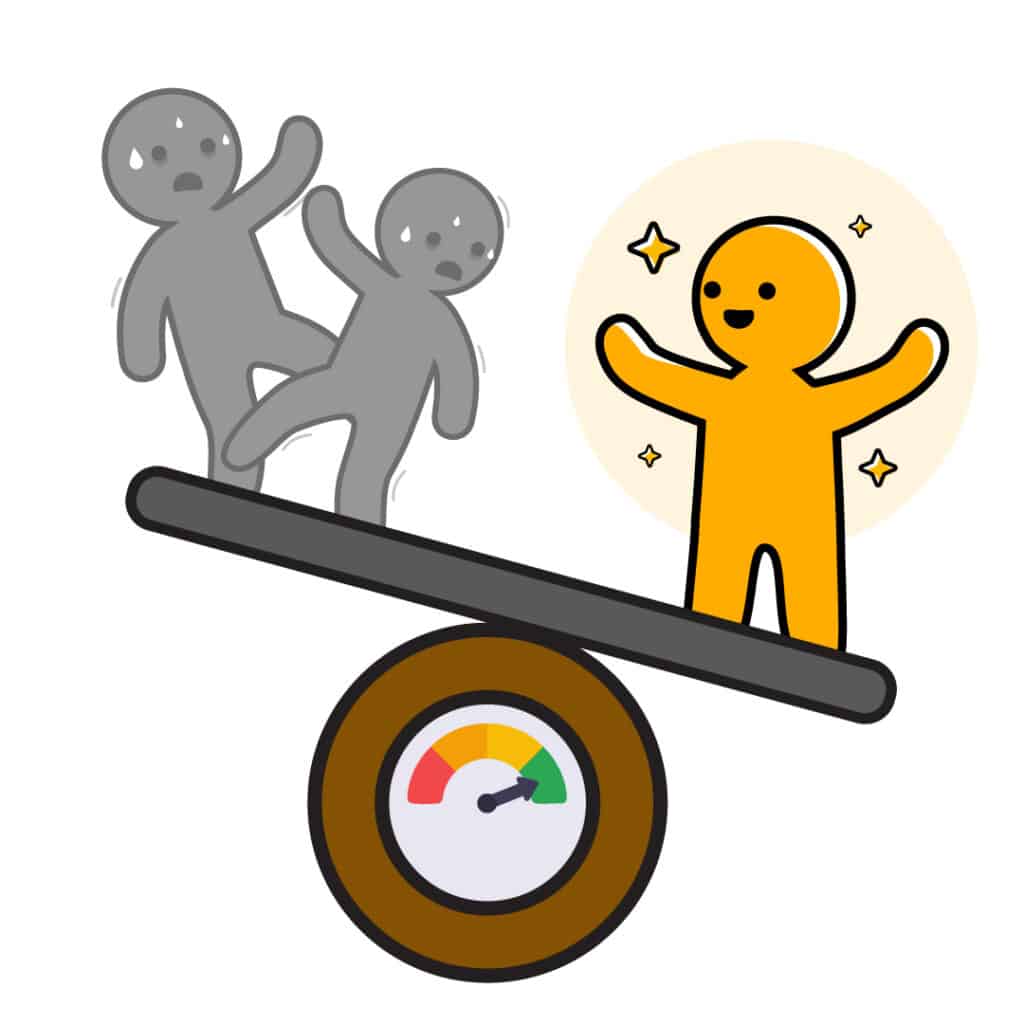The Cost of Not Deciding

Ever had one of those moments where you stare at a restaurant menu for way too long, overwhelmed by all the choices? You finally just order the same thing you always do because it’s easier than making a decision. We’ve all been there. But when it comes to running a credit union, playing it safe and avoiding tough decisions isn’t just about missing out on a new meal—it’s about missing out on growth, success, and sometimes even survival. Right now, we’re seeing a lot of credit unions sitting on the fence. They know they need to make big moves—whether it’s investing in technology, shifting their marketing strategy, or making bold leadership decisions—but they hesitate. And I get it. Change is hard, the unknown is scary, and there’s always that little voice saying, “What if this doesn’t work?” But here’s the thing: Not making a decision is still a decision. And it comes at a cost. The Price of IndecisionEvery time you push a tough choice down the road, you’re not just delaying an outcome—you’re letting opportunities slip away. Consider these statistics: The longer you wait, the higher the cost—whether it’s lost members, declining relevance, or a shrinking bottom line. Making the Tough CallsI’m not saying you should make hasty, reckless decisions. But I am saying that waiting indefinitely for the “perfect time” (spoiler: it doesn’t exist) will do more harm than good. The best leaders—the ones who guide their credit unions to long-term success—understand that growth requires bold moves. It means looking at the data, trusting your instincts, and making the hard calls even when it feels uncomfortable. So, what’s the tough decision you’ve been putting off? Maybe it’s time to finally commit to a strategic growth plan. Maybe it’s time to invest in a better digital experience. Maybe it’s time to shake things up with your brand. Whatever it is, take this as your sign to stop waiting and start moving. Because, ultimately, the cost of not deciding is always higher than the risk of making a move.
The characteristics of a successful credit union leader: is it you?

I recently read an article in The Daily Stoic that reinforced a point I make in every strategic planning session: “Whether you think you can or you think you can’t, you are right.” I begin every strategic planning session this way to set the tone for the day’s discussions. Saying, “Well, we can’t because…” is a sure way to remain stuck in mediocrity. On the other hand, saying, “This would be a challenge, but if we…” opens the door to different actions that lead to different results. In The Daily Stoic, Ryan Holiday shared these thoughts: “Consider this: if you convince yourself that inadequate teachers are the reason you’re not as smart as others, you’ll struggle with learning throughout your life. While your teachers may indeed have been subpar, the limiting story you’ve chosen to believe is the real obstacle. Someone who reframes the same experience differently—’I rose above my underperforming schools through my hunger for learning’ or ‘My street smarts compensate for gaps in my formal education’—will achieve far more in life.” Holiday’s words echo a more modern version of what Epictetus once shared: “Sickness is an impediment to the body but not to the will unless the will wants to be impeded. Lameness is an impediment to the leg, but not to the will. If you tell yourself this every time, you will find the impediment is to something else but not to yourself.” It’s important to remember that Epictetus spoke these exact words while enduring a crippled leg, an injury he sustained during his time as a slave. Now, I challenge you to look at the obstacles facing you as a credit union leader today: Recently, we spent an afternoon with a credit union CEO facing a new and complex challenge. Previously reliable members were falling behind on loan payments, and overdrafts were piling up due to online gambling, pornography, and shopping addictions. “These were members who had challenges, but we could always help. Now, their poor choices are snowballing, and I’m not sure how we can support them through this.” It would have been easy to write them off and shift the credit union’s lending strategy. Instead, we brainstormed ways to reach these members, educate them, and even introduced bold ideas to help them think twice before clicking on those sites or “buy now, pay later” links. What challenge is holding your credit union back right now? Will you let that challenge define your strategy, or will you get creative and shape your own success? If you’re feeling stuck, we can help. For almost 20 years, we’ve helped credit unions gain perspective on the challenges that keep them stuck and find creative marketing strategies to break through and grow. We can help you too.
How Credit Unions Can Differentiate Themselves from Big Banks

In a world where big banks dominate the financial industry with massive marketing budgets and nationwide branches, credit unions often face the challenge of standing out. But here’s the good news: credit unions have something that big banks don’t—a strong sense of community and member-first values. So, how can credit unions highlight these strengths and set themselves apart from the big banks? Here are a few key strategies: 1. Lead with Your Member-Centric Mission Big banks are profit-driven corporations. Credit unions, on the other hand, are member-owned, not-for-profit institutions that reinvest in their members and communities. This mission is a huge differentiator—so make sure your marketing communicates it clearly! 👉 How to highlight it: 2. Personalize the Banking Experience One of the biggest frustrations with big banks is their one-size-fits-all approach. Credit unions have the advantage of knowing their members personally and offering tailored financial solutions. 👉 How to highlight it: 3. Showcase Your Community Impact Credit unions aren’t just financial institutions—they’re pillars of the community. Unlike big banks that answer to shareholders, credit unions invest in local businesses, schools, and community programs. 👉 How to highlight it: 4. Elevate Digital Banking Without Losing the Human Touch Let’s be honest—big banks have an edge when it comes to tech. But credit unions are catching up fast, and they can combine technology with personalized service to create a unique experience. 👉 How to highlight it: 6. Build a Brand That Feels Local, Yet Modern Many people assume credit unions are old-school or outdated. Combat this misconception with a strong brand presence that feels fresh, modern, and approachable. 👉 How to highlight it: 7. Make Switching Easy Even when people love the idea of joining a credit union, they worry about the hassle of switching banks. Make it seamless and stress-free. 👉 How to highlight it: Credit unions already have a winning formula. The key is telling that story effectively and making it easy for potential members to see why they should make the switch. At Your Marketing Co, we help credit unions craft compelling marketing strategies that highlight their unique advantages. Want to stand out from the big banks? Let’s talk.
Speak Human: Why Credit Unions Should Ditch the Financial Jargon

Let’s be honest—most people don’t wake up in the morning excited to talk about APYs, debt-to-income ratios, or share certificates. They wake up thinking about paying their bills, saving for a dream vacation, or how to afford college for their kids. And that’s exactly why credit unions need to rethink the way they communicate. If your messaging is packed with financial lingo that only bankers understand, you’re missing the chance to connect with the very people you’re trying to help. Why Real Language MattersImagine walking into a mechanic’s shop and being bombarded with talk about torque ratios, camshafts, and viscosity indexes when all you wanted was an oil change. You’d probably tune out. That’s exactly how your members feel when you hit them with industry jargon. Real, conversational language makes your credit union approachable, relatable, and—most importantly—helpful. It removes the intimidation factor and helps members feel confident about their financial decisions instead of overwhelmed by complicated terms. The Benefits of Keeping It SimpleUsing everyday language isn’t just a nice thing to do; it actually benefits both your credit union and your members. Here’s how: How to Ditch the JargonMaking the switch to plain language doesn’t mean dumbing things down—it means making them clear. Here’s how: The Bottom LineFinancial jargon might make sense to those of us in the industry, but it creates a barrier between credit unions and the people they serve. By speaking in real, human language, you make it easier for members to engage, trust, and benefit from your services. And that’s what being a credit union is all about. So, the next time you sit down to write a marketing message, ask yourself: Does this sound like a conversation I’d have with a friend? If not, it’s time to rethink the language. Your members will thank you for it.
Why a Unique Value Proposition is Crucial for Credit Unions

Credit unions exist to serve their members, offering financial services with a personal touch that sets them apart from big banks. But in today’s crowded financial landscape, simply being “friendly” or “member-focused” isn’t enough to stand out. That’s where a strong unique value proposition (UVP) to use in your credit union marketing comes into play. Your UVP is what makes your credit union distinct and memorable. It answers the essential question: “Why should someone choose us over the competition?” Without a clear and compelling UVP, your messaging can become generic, blending in rather than standing out. What Makes a Good Value Proposition? A strong UVP should: Examples of Good Value Propositions Let’s take a look at some UVPs that hit the mark: Examples of Weak Value Propositions On the flip side, here are some UVPs that fall flat: How to Develop Your Credit Union’s Unique Value Proposition Creating a compelling UVP requires understanding your members, your strengths, and your competitive landscape. Here’s how to get started: Final Thoughts A unique value proposition is more than just a catchy slogan—it’s the foundation of your brand and marketing strategy. It guides how you communicate with members and prospects, ensuring that every touchpoint reinforces why your credit union is the right choice. If you’re struggling to define your UVP, Your Marketing Co is here to help. For almost 20 years we have helped hundreds of credit unions get unstuck by differentiating themselves. Let’s work together to create a UVP that sets you apart!
How Credit Union Digital Marketing Has Changed in the Last 5 and 10 Years—And How CUs Can Adapt

If there’s one constant in the world of credit union digital marketing, it’s change. Over the last decade, we’ve witnessed shifts that have revolutionized how businesses, including credit unions, connect with their audiences. The pace of these changes has only accelerated in the last five years, leaving many wondering: How can credit unions adapt to stay relevant? Let’s take a look back at some key changes in marketing over the past 5 and 10 years and explore strategies to ensure credit unions thrive in this ever-evolving landscape. The Last 10 Years: The Digital Boom A decade ago, digital marketing was gaining steam, but it hadn’t yet become the dominant force it is today. Social media platforms like Facebook and Twitter X were essential tools, but they were still relatively straightforward—post some content, engage with your audience, and call it a day. Fast forward to today, and digital marketing has exploded into a sophisticated ecosystem. Social media algorithms have grown more complex, video content reigns supreme, and pay-to-play is the norm. Credit unions, which once relied on organic reach, now need to allocate budget to sponsored posts and targeted ads just to maintain visibility. Additionally, the rise of smartphones and mobile apps has completely reshaped member expectations. Members expect seamless, mobile-first experiences. Credit unions that embraced mobile banking early are thriving, while those that lagged behind are playing catch-up. The Last 5 Years: AI, Data, and Personalization In the past five years, the credit union digital marketing landscape has undergone another seismic shift with the advent of AI, advanced data analytics, and hyper-personalization. How Credit Unions Can Adapt Adapting to these changes doesn’t have to be overwhelming. Here are some actionable steps to stay ahead: Change isn’t slowing down. The next five years will likely bring even more disruption to the credit union marketing world. By staying adaptable, investing in the right tools, and keeping members at the heart of your strategies, credit unions can not only survive but thrive in this ever-changing landscape. At Your Marketing Co, we’re passionate about helping credit unions navigate these changes and finding ways to educate, engage, and retain the next generation of credit union members. Together, let’s build marketing strategies that honor your mission while embracing the future.
Big Bank Strategies for Boutique Credit Unions

Fancy, corporate bullshittery for the strategy our most successful credit union clients already employ: focusing on a target market, serving them well, and being okay with not being all things to all people. I was recently on a flight to visit a credit union client, and Jim Cramer was interviewing the CEO of KeyBank, Chris Gorman. In terms of marketing strategy, KeyBank is in a weird limbo. It is too big to be a community bank, but far too small to be considered a megabank. Interestingly enough, it’s actually in a sweet spot, according to Gorman. That’s where their “targeted scale” strategy comes in. KeyBank’s “targeted scale” strategy focuses on achieving growth and efficiency by concentrating resources on specific client segments and business areas, rather than pursuing broad, indiscriminate expansion. This approach enables KeyBank to offer differentiated services tailored to the unique needs of its chosen markets, setting it apart from competitors. Gorman emphasizes that growth should be strategic and client-focused, rather than simply increasing size for its own sake. On a recent episode of the Evergreen Podcast, he states, “I don’t think scale just for scale’s sake makes a ton of sense. It would have to have a very high bar strategically.” An example of this strategy in action is KeyBank’s recent $2.8 billion minority investment from Scotiabank. This capital infusion is intended to strengthen KeyBank’s balance sheet and enhance its capacity for growth in targeted areas, such as investment banking, payments, and wealth management. Gorman notes that the investment, “creates greater capacity for growth by enabling additional investments in targeted scale across our franchise and increases Key’s strategic agility.” By focusing on targeted scale, KeyBank aims to deliver unique, holistic solutions and nontraditional services to its clients, thereby enhancing its competitive position in the financial industry. While KeyBank may be much larger in size than HopeSouth Federal Credit Union ($31million), the “targeted scale” strategy has been just as successful for this small, boutique credit union. Located in a rural, South Carolina county filled with predatory lenders and the abandoned branches of banks that deserted the area through the years, HopeSouth continues to fulfill its mission. They continue providing financial hope by focusing on people who need a fresh start with their finances. It has paid off big over the last decade with an average of 2% ROA, double digit loan growth, and steady membership growth. Recently, in their strategic planning session, the board and leadership team committed to doubling down on their targeted scale strategy with some bold decisions and innovative tactics over the next few years. In the interview with Jim Cramer, Gorman summed up KeyBank targeted scale strategy like this: “Know where we win, how we win, and why we win.” In this new year, if you find yourself stuck, perhaps your strategy needs a reset. Through some tough, strategic conversations and finding your own targeted scale strategy, growth is possible. Over the last two decades, we have helped hundreds of credit unions get unstuck and find pathways to sustainable and meaningful growth. We can do that for you, too.
Credit union creative that works: What is it?

Strategy and creative. Two words that have been the centerpiece of accomplishing our vision of helping credit unions avoid unnecessary mergers. First, if you were to ask any member of the YMC team, “What is the most egregious offense you can commit that would get you fired?” The most likely answer you would receive is, “Using a stock photo of a smiling woman dangling keys out of a car window,” or really any dangling keys in a stock photo. Why? It’s a basic violation of good creative: “Predictability is what makes ads sound and look like ads.” So, when it comes to great creative for credit unions, what is it? How do you create it? Good creative will always answer WIIFM, or “What’s in it for me?” Bad ads are about you and your company. Good ads are about your customers and their happiness. Ads filled with “me, my, we,” and “our,” are about you and your credit union. Ads filled with the words “you” and “your” are about the customer and the happiness you want to bring them. “Our rates are unbeatable…” Doubtful. “We’ve been around since…” so have plenty of your competitors. “We offer great service…” who would claim they didn’t? If any of this sounds familiar, you may have more problems than messaging. At YMC, we utilize a seven-step process, each with a specific, corresponding question, that gets at the heart of WHY someone should choose your credit union. I mean really choose your credit union, without the fluff and corporate bullshittery. The final question in that seven-step process: What result does the ideal member want to avoid? What happens if the ideal member chooses a traditional bank? Or a predatory lender? What happens if they don’t choose your credit union? Take the time to list out 5-6 scenarios. If you cannot come up with at least one very specific, gut-wrenching answer, we’ve got some work to do. Make 2025 the year you choose to get unstuck. For almost 20 years now, we’ve used time-tested processes that result in unique strategies to help credit unions get unstuck and begin to see growth. We have room for one more client to join YMC in Q1 in 2025. Is it you?
Closing Out 2024: End-of-Year Credit Union Marketing Essentials

As the year winds down, credit unions have the perfect opportunity to reflect on their marketing efforts and set the foundation for a strong year ahead. The financial industry is constantly evolving and staying competitive means balancing the lessons of 2024 with innovative strategies for 2025. From wrapping up campaigns to planning fresh initiatives, a thoughtful approach can ensure your credit union continues to connect with members, deliver value, and stand out in the crowded marketplace. Let’s dive into how you can wrap up the year with intention and craft a marketing plan that drives success in the new year. 1. Conduct a Year-End Marketing Audit Before you dive into planning for 2025, assess your 2024 efforts: 2. Celebrate Achievements with Members Engage your community by showcasing the impact your credit union had this year: 3. Optimize Digital Channels Ensure your online presence is fresh and functional heading into the new year: 4. Run an End-of-Year Campaign Capture last-minute engagement with targeted campaigns: Preparing Your 2025 Marketing Plan 1. Set Clear Goals for 2025 Establish marketing goals that align with your credit union’s strategic priorities, such as: 2. Deepen Your Member Understanding Refresh your ideal member personas to ensure your campaigns resonate. Incorporate: 3. Prioritize Digital Transformation With digital banking becoming essential, make sure your marketing reflects this shift: 4. Embrace Emerging Marketing Trends Stay ahead by integrating new strategies: 5. Plan a Robust Content Calendar Build a 2025 content calendar that aligns with seasonal priorities, industry events, and member needs. Include: 6. Budget Strategically Review your 2024 spend and allocate resources wisely for 2025. Invest in areas with proven ROI and consider testing new channels or formats to diversify your approach. Final Thoughts: Start 2025 on the Right Foot Wrapping up the year is more than a task—it’s a chance to solidify your credit union’s reputation and build momentum for the future. By reflecting on what worked in 2024 and crafting a thoughtful, member-focused marketing plan for 2025, you’ll be ready to achieve greater success in the new year. Need help creating your 2025 marketing strategy? Let’s collaborate to make your credit union’s goals a reality!
The first rule of successful credit union marketing is…

The first rule of successful credit union marketing that you must remember is: You are inside of your credit union, looking out. Potential members are outside of your credit union, looking in. Your inside-looking-out perspective makes you blind in one eye. Confirmation bias makes you blind in the other eye. You cannot see yourself the way your potential members see you. You imagine they see you based on your mission statement, your policies and procedures, your good intentions, your employee training… You imagine that potential credit union members see you the way you want to be seen. You see those things—you care about those things! Your potential member doesn’t know or see them, not yet. And (GASP!) they don’t care. They have problems. Big problems. They have debt spiraling out of control, causing stress and anxiety. They are living paycheck to paycheck, wondering what to do when that one small emergency inevitably happens, and they don’t have the means to fix it. They worry they will miss their kids’ games, performances, and lives because they have to work overtime to make ends meet. Here’s the hard truth: When you’ve convinced your credit union marketing person to see your credit union the same way you do, that marketing person has nothing left to offer you but flattery—not results. Back in my radio days, this weathered, old ad guy once said something I’ve carried with me to this day: “Our industry is drowning in math and starving for ideas. We need people who can dream shit up. We need impractical, illogical people. We have plenty of data. We need more of the opposite. We have forgotten that the only unique benefits we can provide to clients is imaginative thinking and creativity. Everything else, aside from ideas, they can get somewhere else. Good ideas are good ideas. Things that are entertaining, interesting, and uplifting will always be attractive to everyone.” It comes down to the basic principles of advertising, and business in general. Some thoughts to consider: “Good inventors and designers (and marketers) deeply understand their customer. They spend tremendous energy developing that intuition. They study and understand many anecdotes rather than only the averages you’ll find on surveys.” – Jeff Bezos, Amazon “First principles is kind of a physics way of looking at the world. You boil things down to the most fundamental truths and say, ‘What are we sure is true?’ … and then reason up from there.” – Elon Musk, Tesla and SpaceX “Every moment in business happens only once. The next Bill Gates will not build an operating system. The next Larry Page or Sergey Brin won’t make a search engine. And the next Mark Zuckerberg won’t create a social network. If you are copying these guys, you aren’t learning from them… Indeed, the single most powerful pattern I have noticed is that successful people find value in unexpected places, and they do this by thinking about business from first principles instead of formulas.” – Peter Thiel, PayPal Credit union marketing strategies are successful when we remember these basic principles. Your members aren’t looking for a product or a service. They are looking for transformation. They are looking for a solution. They want a hole in the wall but need the hammer to make it happen. In short: Don’t try to convince your members and potential members to think and feel like you do. Learn how to think and feel like them.











